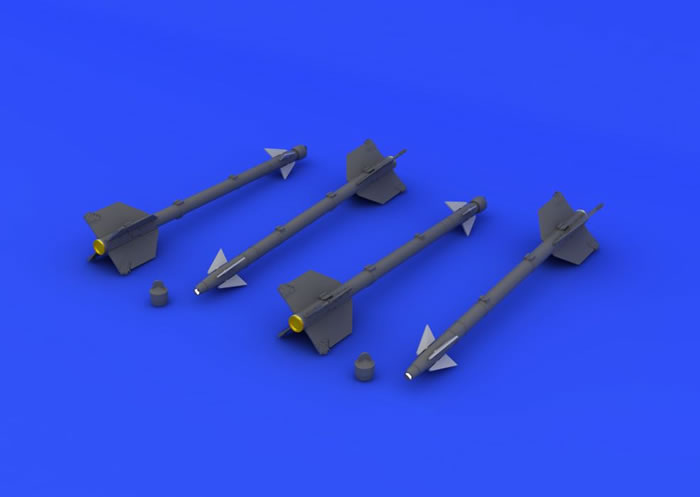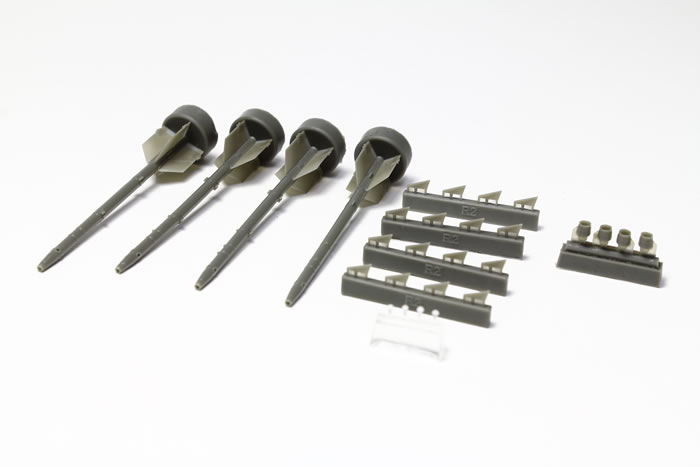AIM-9D Sidewinder Missiles

(CAD illustration courtesy of Eduard website)
Eduard BRASSIN, 1/48 scale
S u m m a r y : |
Catalogue Number |
Eduard BRASSIN Item No. 648 156 - AIM-9D Sidewinders |
Contents and media |
24 resin pieces, 4 clear resin pieces, 1 decal sheet, 1 photo etch fret. |
Scale |
1/48 |
Price: |
USD12.95 plus shipping available online from Eduard’s website |
Review Type |
First Look |
Advantages: |
Simple construction, excellent enhancement set. |
Disadvantages: |
None noted. |
Recommendation: |
Easy build, easy paint. Recommended. |
Reviewed by Mick Drover

Eduard's 1/48 scale MiG-21R Interior is available online from Squadron.com
Background by Jim Rotramel |
A quick bit of history. The AIM-9D/G/H all looked the same, so for modeling purposes you can use these models for any of the three variants.
The AIM-9Ds were the initial improved Sidewinders and suffered teething problems that delayed their introduction into service. Although they shared the same AIM-9 designation with the earlier AIM-9B, it was a completely new missile, with every component redesigned. One of the most important changes was the seeker, which used nitrogen to cool its detector. This change required a completely new launcher, the LAU-7/A to hold a large bottle of nitrogen gas.
Although the USAF had initially planned to acquire AIM-9Ds, when faced with its production delays, they elected to modify their AIM-9Bs into AIM-9Es (and subsequently -9Js, -9Ns and -9Ps). So, although the USAF bought some of the LAU-7A/A launchers needed for the new missile (and used them in combat with the 8th TFW), they never bought any AIM-9D/G/H missiles.
The AIM-9Ds saw action during Operation Rolling Thunder with the USN/USMC, but were replaced by AIM-9Gs by the time of Operation Linebacker in 1972. Some AIM-9Ds were given to Israel during the 1973 Yom Kipper War, and the U.K. also bought some. Actual production numbers are a bit murky, but no more than 1,850 were built.
The AIM-9G introduced the Sidewinder Expanded Acquisition Mode (SEAM), giving it an off boresight launch capability. This was the missile that scored most of the USN kills during Operation Linebacker. Only slightly more than 2,000 AIM-9Gs were produced, with 480 being provided to Israel during the Yom Kipper War. By the mid-1970s (post-Vietnam), SEAM could be used with the Visual Target Acquisition System (VTAS), which incorporated a helmet-mounted reticle in 500 USN/USMC Phantoms. British Harrier GR.3s carried AIM-9Gs during the 1982 Falklands War and some were also exported to the UAE.
The AIM-9H was an AIM-9G with solid-state electronic components for increased reliability. It entered service in 1973 and nearly 8,000 were produced by 1978. In Swedish service, it was called the Rb 24H.
Bottom Line rule of thumb: Rolling Thunder--AIM-9D; Linebacker--AIM-9G; Post Vietnam--AIM-9H (but they all look the same externally and the seekers were NEVER(!) black, but a anodized finish that was generally a kind of dark greenish gray color).
(Background by Jim Rotramel)
As with most of Eduard’s 1/48 air-to-air missiles, the AIM-9D is a very simple build. Carefully remove the forward wings and use the photo etch guide to position them squarely to the missile body. A small amount of CA should do the trick to secure the wings to the missile body.
 
The final pieces of photo etch are supplied for the rear of the rocket motor. A small decal sheet provides stencils for the missile body. The option of either a clear resin seeker head or a seeker head cover is provided.
The instructions are the usual Eduard standard with a simple construction and painting guide. Paint callouts are made in Gunze Aqueous and Mr Color. The detail in the resin is excellent, you just need to have a look at the photos that I’ve taken below.

The launch rail guides are moulded onto the missile body and the guidance fins are suitably thin.
Once painted up and decalled, these set of Sidewinders will look great on a US Navy or US Air Force Vietnam war era jet.
Recommended.
Thanks to Eduard for the samples and images.
Review Text Copyright © 2015 by Mick Drover
Page Created 29 April, 2015
Last updated
30 April, 2015
Back to HyperScale Main Page
Back to Reviews Page

|
